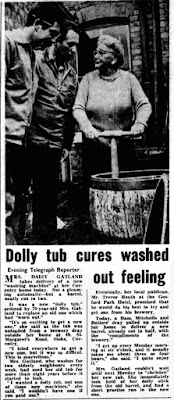You never had problems with a dolly tub. They worked every time. Mum would boil water in the copper in the wash house at the end of the garden, ladle it into the dolly tub and swish the washing round with what she called a ‘peggy stick’. Then it was through the ‘wringer’ and on to the washing line to dry. Or if raining, it was hung on the ‘creel’ clothes rack descending by pulley from the scullery ceiling. Tried, tested, reliable technology. Mind you, it wasn’t a good idea to leave your clothes on the rack for long, especially when frying bacon.
Even when we got a top-loading Ada washing machine with a powered ‘wringer’ on top it ran trouble-free for years. You just had to be careful not to catch your thumbs in the mangle. Its newer replacements and stand-alone spin dryers were never much hassle either.
My recent post about donkey stones sparked off quite a few comments about dolly tubs and mangles. I see the association too, even though donkey stones had nothing to do with washdays. There are lots of evocative photographs on the internet. Here are some closest to what I remember.
 |
| Top: brick copper with a fireplace for heating water, dolly tub and stick, brass posser, wringer (mangle). Bottom: wooden clothes horse, creel (pulley clothes rack), 1950s Ada washing machine |
What you can’t recreate, of course, are the sensations: the rattle of a peg round the corrugations of an empty dolly tub, the soft, smooth weight of a dolly stick, the ring of a brass posser, the steamy heat of the brick copper, the smell of soap flakes and wet washing, the brace of a clothes prop against a washing line on a windy day, condensation running down the walls, steamed up windows.
The Ada drawing reminded me of the door on the front and low switch and lever on the side, things I’d forgotten completely. I suppose I must have spent quite a lot of time at floor level in those days. We got the Ada around 1953. Later that decade, we bought a stand-alone spin dryer. They were replaced by nineteen-sixties models. I am not sure whether my parents ever had a twin-tub, but, like most households in Britain, they moved up to a front-loading automatic washing machine during the nineteen-seventies.
The old dolly tubs were not entirely trouble free. Archive newspapers contain many sad stories of children drowning in them, and eventually they sprang leaks. One elderly woman in Coventry, among the last to use one, found that by 1968 it was almost impossible to replace. A local brewery came to her aid with a sawn-in-half beer barrel. It was also best to use good soap flakes – it seems nothing could be worse than undissolved soap in your undies. But you could claim any brown or yellowish stains were from the wooden creel or clothes horse.
Back to our present-day troubles. Sometimes you could get the washing machine to work by starting again on a different programme. At other times you had to put it on spin to pump out the water (even though it wouldn’t actually spin), take out the wet washing and begin again with just half a load. You sat there twiddling thumbs waiting for the timer to unlock the door. We never knew whether it was going to indulge us or not. We were ready to call out a repairer (knowing, of course, that it would work perfectly when the repairer came) or simply just buy a new one, even though it’s a good model and only a few years old.
In the end we didn’t need to. It dawned on us that the problem might be something to do with the weight of the load: a faulty sensor perhaps. It appears the Samsung ecobubble weighs the washing to decide how much water it needs: a great idea in principle with the potential to save both water and electricity, but not such a great idea when it goes wrong.
The problem had also become much worse since we moved the machine from one end of the kitchen to the other. Did you know that with some modern washing machines, when first installed, or when moved, you are supposed to calibrate the load sensor? The deliverers/installers did not do this, nor the plumbers when they moved it. Once you know, the instructions in the user manual are straightforward.
Too clever by half! It has been trouble free since we did that. But my mother never had to calibrate her dolly tub or wringer, and the only load sensor she needed was the judgement not to hang so much weight on the clothes rack as to bring down the kitchen ceiling.
Now don’t get me started on outside toilets. Here is another picture of that lady in her underwear.
To be able to see the newspaper articles large enough to read (on Windows PCs) you may need to (1) left-click the image to get a slightly larger version (2) right-click the new image which brings up a menu (3) depending on which browser you are using you can then select one of the following: view image, view image in new tab, save image (4) if you have saved the image you should be able to find it on your desktop or in "my pictures", and should then be able to open and enlarge it in your default image viewer.








